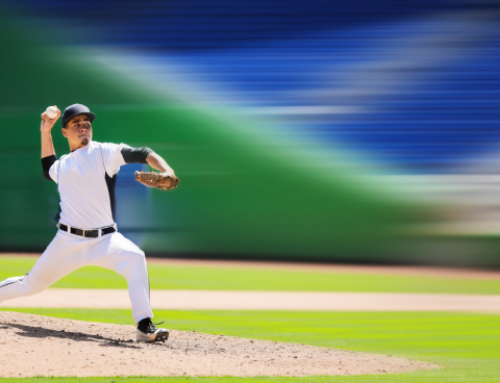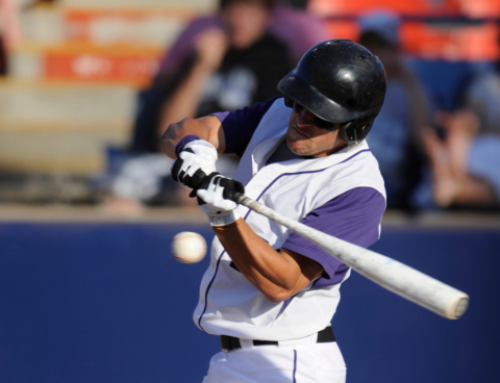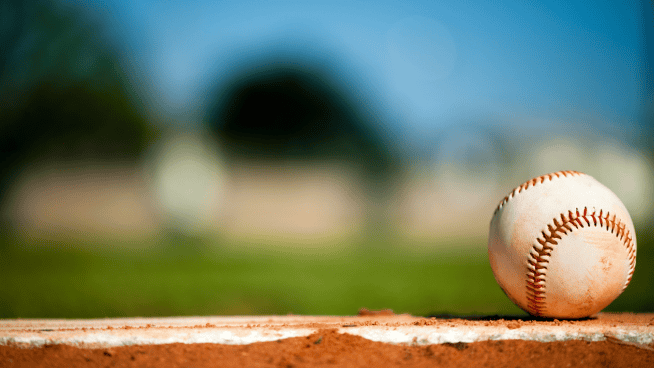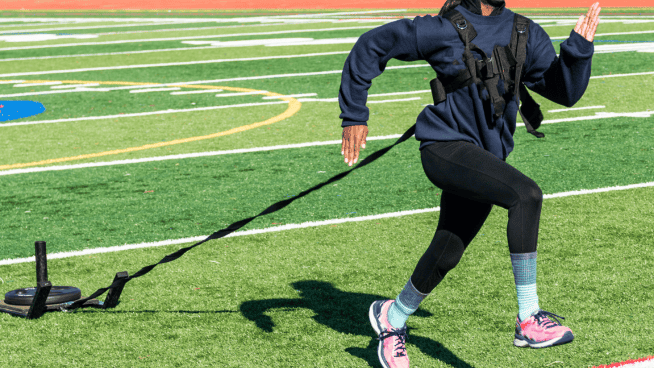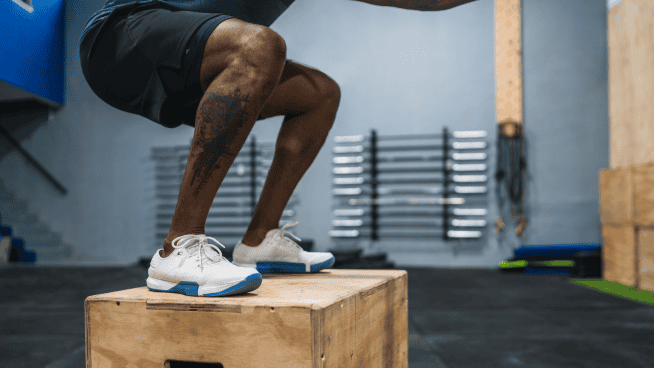Is Every Baseball Glove The Same?
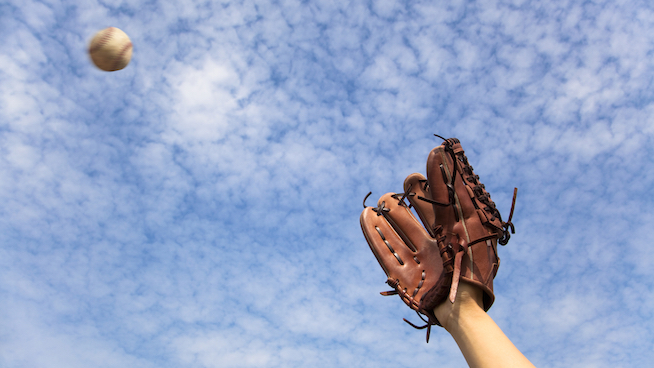
Not all baseball gloves are the same size. Glove sizes and shapes will vary depending on a player’s age and position.
As a general rule, infielders use smaller gloves than outfielders for a couple of reasons.
First, infielders need to get the ball out of their glove quickly. A fraction of a second can be the difference between a runner being called safe or out, so infielders need to be able to transfer the ball from their glove to their throwing hand lightning-fast. A smaller design helps, as it reduces the chance the ball will get “lost” inside the glove.
Infielders‘ gloves also tend to be thinner and lighter, allowing for more nimble hand movements. This is an advantage, because infielders have less time to react to hard-hit balls than outfielders.
Outfielders‘ gloves are typically larger and heavier than infielders’ gloves. This makes it more difficult to get the ball out quickly, but the larger design gives them a bigger target to catch with. When it comes to robbing a batter of a home run or making a diving catch on a sinking liner, a larger glove gives the outfielder more surface area to receive the ball.
The two exceptions to these standards are first baseman gloves and catchers’ mitts. First baseman gloves (often called “mitts” because they lack individual fingers) are larger than typical infielder glove and have a deeper pocket. This is an advantage for first basemen since they often have to scoop balls out of the dirt. It also gives the other infielders a larger target to throw to. Since first basemen don’t have to make quick transfers as often as, say, a shortstop, this design works well.
Catchers’ mitts are used exclusively by the catcher. They’re heavily padded and have a unique wide shape that helps guide balls into the pocket. A catcher’s number one job is to keep the ball in front of himself, making this design advantageous.
Is There a Limit on How Large a Baseball Glove Can Be?
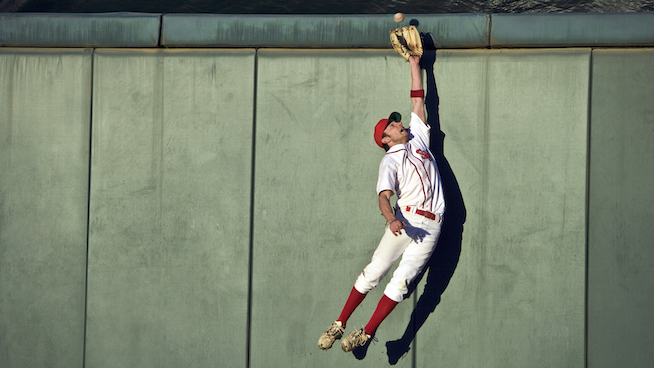
Yes. Although lower levels of baseball might lack explicit rules regarding glove sizes, many high school athletic associations promulgate them. And the NCAA and the MLB have strict glove size limits.
Here are the NCAA rules, which many high school athletic associations also adhere to:
- The catcher may wear a glove or mitt of any dimension
- Every player except the catcher is restricted to the use of a glove that is no more than 13 inches long or 8 inches wide
Here are the MLB rules:
- The catcher may wear a mitt no more than 38 inches in circumference or 15.5 inches from top to bottom
- The first baseman’s mitt must be no more than 13 inches long or 8 inches wide
- Every player except the catcher and the first baseman are restricted to the use of a glove that is no more than 13 inches long or 7.75 inches wide
How is Baseball Glove Size Measured?
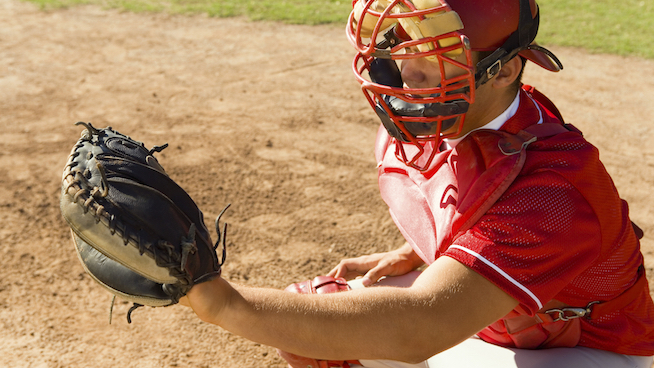
Glove size measuring procedures vary slightly between college and the pros.
Here are the MLB rules:
For fielders’ gloves, the length of the glove is measured from the bottom edge of the heel pocket up through the ball pocket to the tip of the longest of any of the four fingers. The width of the glove is measured from the inside seam at the base of the first finger along the base of the other fingers to the outside edge of the little finger of the glove.
Catchers’ mitts are measured around the outside of the mitt and include all lacing and any leather band or facing attached to the outer edge. The space between the thumb section and the finger section of the mitt shall not exceed six inches at the top of the mitt and four inches at the base of the thumb crotch.
Here are the NCAA rules:
The length measurement of any glove shall be from the bottom edge or heel straight up across the palm. Fielders’ gloves are measured in width from the base of the inside seam of the first finger to the outside edge of the little finger. First baseman mitts are measured in width from the center of the base section between the thumb and first finger to the outside edge of the little finger.
Since NCAA rules allow catchers to wear a mitt of any dimension, there’s no standard for measurement.
What Size Glove is Right For Me?
That’s a tough question. The answer depends on your age, position and the rules of the league in which you currently compete (or will compete). This chart, based on info from Rawlings (the most popular brand of glove in the MLB according to WhatProsWear.com), is a good place to start:
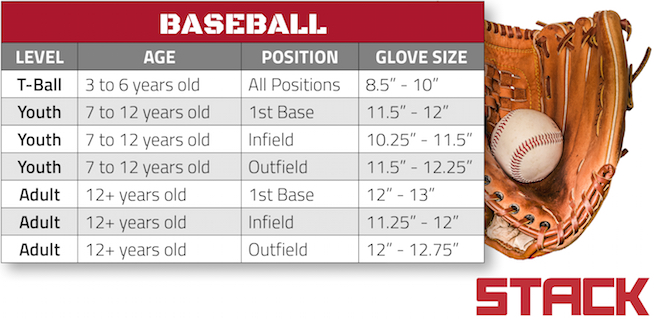
Talking to a knowledgeable salesperson can be a great way to find the perfect glove for you.
READ MORE:
RECOMMENDED FOR YOU
MOST POPULAR
Is Every Baseball Glove The Same?

Not all baseball gloves are the same size. Glove sizes and shapes will vary depending on a player’s age and position.
As a general rule, infielders use smaller gloves than outfielders for a couple of reasons.
First, infielders need to get the ball out of their glove quickly. A fraction of a second can be the difference between a runner being called safe or out, so infielders need to be able to transfer the ball from their glove to their throwing hand lightning-fast. A smaller design helps, as it reduces the chance the ball will get “lost” inside the glove.
Infielders‘ gloves also tend to be thinner and lighter, allowing for more nimble hand movements. This is an advantage, because infielders have less time to react to hard-hit balls than outfielders.
Outfielders‘ gloves are typically larger and heavier than infielders’ gloves. This makes it more difficult to get the ball out quickly, but the larger design gives them a bigger target to catch with. When it comes to robbing a batter of a home run or making a diving catch on a sinking liner, a larger glove gives the outfielder more surface area to receive the ball.
The two exceptions to these standards are first baseman gloves and catchers’ mitts. First baseman gloves (often called “mitts” because they lack individual fingers) are larger than typical infielder glove and have a deeper pocket. This is an advantage for first basemen since they often have to scoop balls out of the dirt. It also gives the other infielders a larger target to throw to. Since first basemen don’t have to make quick transfers as often as, say, a shortstop, this design works well.
Catchers’ mitts are used exclusively by the catcher. They’re heavily padded and have a unique wide shape that helps guide balls into the pocket. A catcher’s number one job is to keep the ball in front of himself, making this design advantageous.
Is There a Limit on How Large a Baseball Glove Can Be?

Yes. Although lower levels of baseball might lack explicit rules regarding glove sizes, many high school athletic associations promulgate them. And the NCAA and the MLB have strict glove size limits.
Here are the NCAA rules, which many high school athletic associations also adhere to:
- The catcher may wear a glove or mitt of any dimension
- Every player except the catcher is restricted to the use of a glove that is no more than 13 inches long or 8 inches wide
Here are the MLB rules:
- The catcher may wear a mitt no more than 38 inches in circumference or 15.5 inches from top to bottom
- The first baseman’s mitt must be no more than 13 inches long or 8 inches wide
- Every player except the catcher and the first baseman are restricted to the use of a glove that is no more than 13 inches long or 7.75 inches wide
How is Baseball Glove Size Measured?

Glove size measuring procedures vary slightly between college and the pros.
Here are the MLB rules:
For fielders’ gloves, the length of the glove is measured from the bottom edge of the heel pocket up through the ball pocket to the tip of the longest of any of the four fingers. The width of the glove is measured from the inside seam at the base of the first finger along the base of the other fingers to the outside edge of the little finger of the glove.
Catchers’ mitts are measured around the outside of the mitt and include all lacing and any leather band or facing attached to the outer edge. The space between the thumb section and the finger section of the mitt shall not exceed six inches at the top of the mitt and four inches at the base of the thumb crotch.
Here are the NCAA rules:
The length measurement of any glove shall be from the bottom edge or heel straight up across the palm. Fielders’ gloves are measured in width from the base of the inside seam of the first finger to the outside edge of the little finger. First baseman mitts are measured in width from the center of the base section between the thumb and first finger to the outside edge of the little finger.
Since NCAA rules allow catchers to wear a mitt of any dimension, there’s no standard for measurement.
What Size Glove is Right For Me?
That’s a tough question. The answer depends on your age, position and the rules of the league in which you currently compete (or will compete). This chart, based on info from Rawlings (the most popular brand of glove in the MLB according to WhatProsWear.com), is a good place to start:

Talking to a knowledgeable salesperson can be a great way to find the perfect glove for you.
READ MORE:



